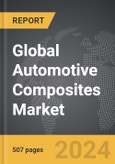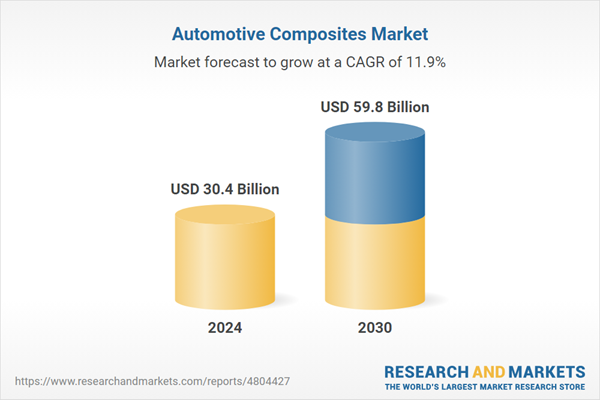The global market for Automotive Composites was valued at US$30.4 Billion in 2024 and is projected to reach US$59.8 Billion by 2030, growing at a CAGR of 11.9% from 2024 to 2030. This comprehensive report provides an in-depth analysis of market trends, drivers, and forecasts, helping you make informed business decisions. The report includes the most recent global tariff developments and how they impact the Automotive Composites market.
Technological advancements in the production and application of automotive composites have significantly expanded their use and improved their performance. Innovations in manufacturing processes, such as resin transfer molding (RTM) and automated fiber placement (AFP), have made it possible to produce complex composite components with high precision and efficiency. The development of new composite materials, such as thermoplastic composites, has further broadened the scope of applications by offering improved recyclability and faster processing times. Additionally, the integration of nanotechnology into composite materials has led to the creation of nanocomposites with superior mechanical properties and enhanced functionality, such as improved thermal conductivity and electromagnetic shielding. These advancements are driving the adoption of composites in high-performance and luxury vehicles, as well as in mainstream automotive manufacturing.
The growth in the automotive composites market is driven by several factors, reflecting the industry's evolving needs and technological advancements. One significant driver is the increasing demand for lightweight materials to improve fuel efficiency and reduce carbon emissions, particularly in light of stringent environmental regulations and the push for sustainable mobility solutions. The rise of electric vehicles (EVs) also contributes to market growth, as composites are essential for reducing the weight of battery packs and improving the overall range and performance of EVs. Additionally, the automotive industry's focus on safety and crashworthiness fuels the demand for high-strength composite materials that enhance vehicle structural integrity. Technological innovations in composite manufacturing, which reduce production costs and time, further propel market expansion by making these materials more accessible and cost-effective for mass production. The continuous advancements in composite materials, coupled with growing investments in research and development, ensure the dynamic growth and evolution of the automotive composites market.
Segments: Fiber Type (Glass Fiber, Carbon Fiber, Other Fiber Types); Resin Type (Thermoplastic, Thermoset); Application (Exteriors, Interiors, Powertrain, Other Applications).
Geographic Regions/Countries: World; USA; Canada; Japan; China; Europe; France; Germany; Italy; UK; Spain; Russia; Rest of Europe; Asia-Pacific; Australia; India; South Korea; Rest of Asia-Pacific; Latin America; Argentina; Brazil; Mexico; Rest of Latin America; Middle East; Iran; Israel; Saudi Arabia; UAE; Rest of Middle East; Africa.
The analysts continuously track trade developments worldwide, drawing insights from leading global economists and over 200 industry and policy institutions, including think tanks, trade organizations, and national economic advisory bodies. This intelligence is integrated into forecasting models to provide timely, data-driven analysis of emerging risks and opportunities.
Global Automotive Composites Market - Key Trends & Drivers Summarized
Automotive composites are advanced materials used extensively in the automotive industry to enhance vehicle performance, efficiency, and safety. These composites are typically made from a combination of high-strength fibers, such as carbon or glass, embedded in a polymer matrix. The resulting materials are lightweight yet incredibly strong, making them ideal for various automotive applications, including body panels, chassis components, and interior parts. The use of composites in automotive manufacturing helps reduce the overall weight of vehicles, which in turn improves fuel efficiency and reduces emissions. Additionally, the high strength-to-weight ratio of composites enhances the safety and durability of vehicles, providing better crash resistance and longer component life.Technological advancements in the production and application of automotive composites have significantly expanded their use and improved their performance. Innovations in manufacturing processes, such as resin transfer molding (RTM) and automated fiber placement (AFP), have made it possible to produce complex composite components with high precision and efficiency. The development of new composite materials, such as thermoplastic composites, has further broadened the scope of applications by offering improved recyclability and faster processing times. Additionally, the integration of nanotechnology into composite materials has led to the creation of nanocomposites with superior mechanical properties and enhanced functionality, such as improved thermal conductivity and electromagnetic shielding. These advancements are driving the adoption of composites in high-performance and luxury vehicles, as well as in mainstream automotive manufacturing.
The growth in the automotive composites market is driven by several factors, reflecting the industry's evolving needs and technological advancements. One significant driver is the increasing demand for lightweight materials to improve fuel efficiency and reduce carbon emissions, particularly in light of stringent environmental regulations and the push for sustainable mobility solutions. The rise of electric vehicles (EVs) also contributes to market growth, as composites are essential for reducing the weight of battery packs and improving the overall range and performance of EVs. Additionally, the automotive industry's focus on safety and crashworthiness fuels the demand for high-strength composite materials that enhance vehicle structural integrity. Technological innovations in composite manufacturing, which reduce production costs and time, further propel market expansion by making these materials more accessible and cost-effective for mass production. The continuous advancements in composite materials, coupled with growing investments in research and development, ensure the dynamic growth and evolution of the automotive composites market.
Report Scope
The report analyzes the Automotive Composites market, presented in terms of units. The analysis covers the key segments and geographic regions outlined below.Segments: Fiber Type (Glass Fiber, Carbon Fiber, Other Fiber Types); Resin Type (Thermoplastic, Thermoset); Application (Exteriors, Interiors, Powertrain, Other Applications).
Geographic Regions/Countries: World; USA; Canada; Japan; China; Europe; France; Germany; Italy; UK; Spain; Russia; Rest of Europe; Asia-Pacific; Australia; India; South Korea; Rest of Asia-Pacific; Latin America; Argentina; Brazil; Mexico; Rest of Latin America; Middle East; Iran; Israel; Saudi Arabia; UAE; Rest of Middle East; Africa.
Key Insights:
- Market Growth: Understand the significant growth trajectory of the Exteriors segment, which is expected to reach US$22.6 Billion by 2030 with a CAGR of a 11.1%. The Interiors segment is also set to grow at 11.9% CAGR over the analysis period.
- Regional Analysis: Gain insights into the U.S. market, valued at $5.9 Billion in 2024, and China, forecasted to grow at an impressive 16.0% CAGR to reach $17.3 Billion by 2030. Discover growth trends in other key regions, including Japan, Canada, Germany, and the Asia-Pacific.
Why You Should Buy This Report:
- Detailed Market Analysis: Access a thorough analysis of the Global Automotive Composites Market, covering all major geographic regions and market segments.
- Competitive Insights: Get an overview of the competitive landscape, including the market presence of major players across different geographies.
- Future Trends and Drivers: Understand the key trends and drivers shaping the future of the Global Automotive Composites Market.
- Actionable Insights: Benefit from actionable insights that can help you identify new revenue opportunities and make strategic business decisions.
Key Questions Answered:
- How is the Global Automotive Composites Market expected to evolve by 2030?
- What are the main drivers and restraints affecting the market?
- Which market segments will grow the most over the forecast period?
- How will market shares for different regions and segments change by 2030?
- Who are the leading players in the market, and what are their prospects?
Report Features:
- Comprehensive Market Data: Independent analysis of annual sales and market forecasts in US$ Million from 2024 to 2030.
- In-Depth Regional Analysis: Detailed insights into key markets, including the U.S., China, Japan, Canada, Europe, Asia-Pacific, Latin America, Middle East, and Africa.
- Company Profiles: Coverage of players such as BASF SE, Gurit Services AG, Hexcel Corporation, Huntsman Corporation, Mitsubishi Chemical Holding Corporation and more.
- Complimentary Updates: Receive free report updates for one year to keep you informed of the latest market developments.
Some of the 92 companies featured in this Automotive Composites market report include:
- BASF SE
- Gurit Services AG
- Hexcel Corporation
- Huntsman Corporation
- Mitsubishi Chemical Holding Corporation
- Owens Cornings
- SGL Carbon SE
- Sigmatex (UK) Limited
- Syensqo
- Teijin Limited
- Toray Advanced Composites
- UFP Technologies, Inc.
Tariff Impact Analysis: Key Insights for 2025
Global tariff negotiations across 180+ countries are reshaping supply chains, costs, and competitiveness. This report reflects the latest developments as of April 2025 and incorporates forward-looking insights into the market outlook.The analysts continuously track trade developments worldwide, drawing insights from leading global economists and over 200 industry and policy institutions, including think tanks, trade organizations, and national economic advisory bodies. This intelligence is integrated into forecasting models to provide timely, data-driven analysis of emerging risks and opportunities.
What’s Included in This Edition:
- Tariff-adjusted market forecasts by region and segment
- Analysis of cost and supply chain implications by sourcing and trade exposure
- Strategic insights into geographic shifts
Buyers receive a free July 2025 update with:
- Finalized tariff impacts and new trade agreement effects
- Updated projections reflecting global sourcing and cost shifts
- Expanded country-specific coverage across the industry
Table of Contents
I. METHODOLOGYMII. EXECUTIVE SUMMARY2. FOCUS ON SELECT PLAYERSIII. MARKET ANALYSISINDIASOUTH KOREAREST OF ASIA-PACIFICLATIN AMERICAARGENTINABRAZILMEXICOREST OF LATIN AMERICAMIDDLE EASTAFRICAIV. COMPETITION
1. MARKET OVERVIEW
3. MARKET TRENDS & DRIVERS
4. GLOBAL MARKET PERSPECTIVE
UNITED STATES
CANADA
JAPAN
CHINA
EUROPE
FRANCE
GERMANY
ITALY
UNITED KINGDOM
SPAIN
RUSSIA
REST OF EUROPE
ASIA-PACIFIC
Companies Mentioned (Partial List)
A selection of companies mentioned in this report includes, but is not limited to:
- BASF SE
- Gurit Services AG
- Hexcel Corporation
- Huntsman Corporation
- Mitsubishi Chemical Holding Corporation
- Owens Cornings
- SGL Carbon SE
- Sigmatex (UK) Limited
- Syensqo
- Teijin Limited
- Toray Advanced Composites
- UFP Technologies, Inc.
Table Information
| Report Attribute | Details |
|---|---|
| No. of Pages | 507 |
| Published | April 2025 |
| Forecast Period | 2024 - 2030 |
| Estimated Market Value ( USD | $ 30.4 Billion |
| Forecasted Market Value ( USD | $ 59.8 Billion |
| Compound Annual Growth Rate | 11.9% |
| Regions Covered | Global |









